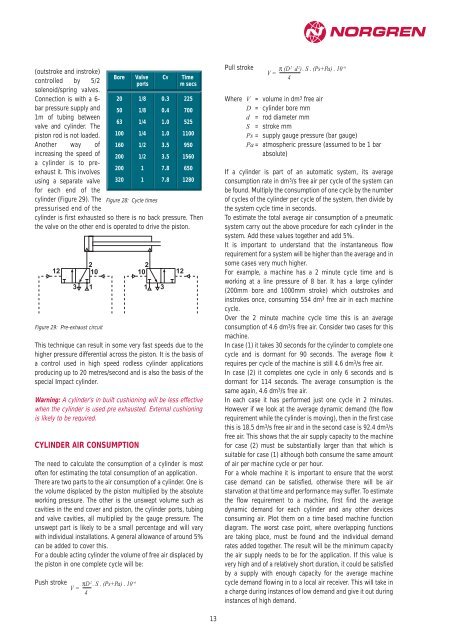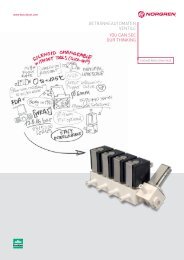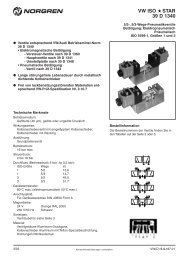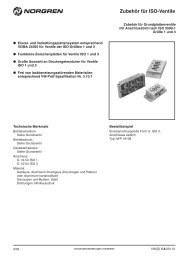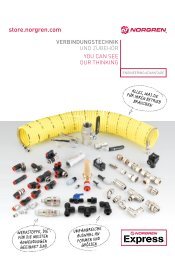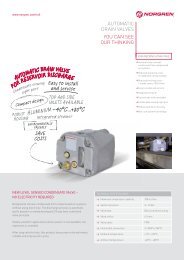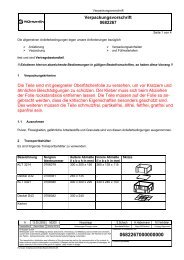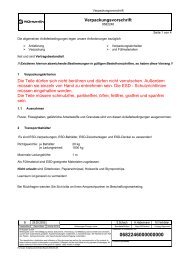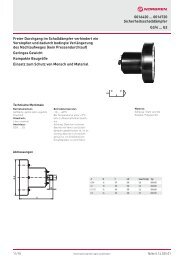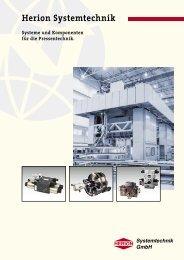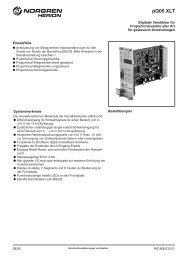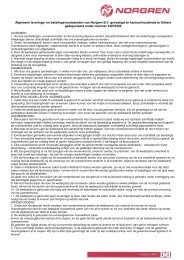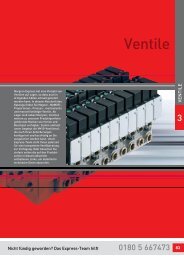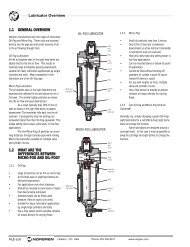Actuator Guide - Norgren Pneumatics. Motion Control Equipment ...
Actuator Guide - Norgren Pneumatics. Motion Control Equipment ...
Actuator Guide - Norgren Pneumatics. Motion Control Equipment ...
You also want an ePaper? Increase the reach of your titles
YUMPU automatically turns print PDFs into web optimized ePapers that Google loves.
(outstroke and instroke)<br />
controlled by 5/2<br />
solenoid/spring valves.<br />
Bore Valve<br />
ports<br />
Cv Time<br />
m secs<br />
Connection is with a 6- 20 1/8 0.3 225<br />
bar pressure supply and 50 1/8 0.4 700<br />
1m of tubing between<br />
valve and cylinder. The<br />
63 1/4 1.0 525<br />
piston rod is not loaded. 100 1/4 1.0 1100<br />
Another way of 160 1/2 3.5 950<br />
increasing the speed of<br />
a cylinder is to preexhaust<br />
it. This involves<br />
200<br />
200<br />
1/2<br />
1<br />
3.5<br />
7.8<br />
1560<br />
650<br />
using a separate valve<br />
for each end of the<br />
320 1 7.8 1280<br />
cylinder (Figure 29). The Figure 28: Cycle times<br />
pressurised end of the<br />
cylinder is first exhausted so there is no back pressure. Then<br />
the valve on the other end is operated to drive the piston.<br />
2<br />
2<br />
12 10<br />
10 12<br />
3<br />
Figure 29: Pre-exhaust circuit<br />
This technique can result in some very fast speeds due to the<br />
higher pressure differential across the piston. It is the basis of<br />
a control used in high speed rodless cylinder applications<br />
producing up to 20 metres/second and is also the basis of the<br />
special Impact cylinder.<br />
Warning: A cylinder’s in built cushioning will be less effective<br />
when the cylinder is used pre exhausted. External cushioning<br />
is likely to be required.<br />
CYLINDER AIR CONSUMPTION<br />
The need to calculate the consumption of a cylinder is most<br />
often for estimating the total consumption of an application.<br />
There are two parts to the air consumption of a cylinder. One is<br />
the volume displaced by the piston multiplied by the absolute<br />
working pressure. The other is the unswept volume such as<br />
cavities in the end cover and piston, the cylinder ports, tubing<br />
and valve cavities, all multiplied by the gauge pressure. The<br />
unswept part is likely to be a small percentage and will vary<br />
with individual installations. A general allowance of around 5%<br />
can be added to cover this.<br />
For a double acting cylinder the volume of free air displaced by<br />
the piston in one complete cycle will be:<br />
Push stroke πD<br />
V =<br />
4<br />
2 . S . (Ps+Pa) . 10 -6<br />
1<br />
1 3<br />
13<br />
Pull stroke<br />
V =<br />
π (D<br />
4<br />
2 - d 2 ) . S . (Ps+Pa) . 10 -6<br />
Where V = volume in dm 3 free air<br />
D = cylinder bore mm<br />
d = rod diameter mm<br />
S = stroke mm<br />
Ps = supply gauge pressure (bar gauge)<br />
Pa = atmospheric pressure (assumed to be 1 bar<br />
absolute)<br />
If a cylinder is part of an automatic system, its average<br />
consumption rate in dm 3 /s free air per cycle of the system can<br />
be found. Multiply the consumption of one cycle by the number<br />
of cycles of the cylinder per cycle of the system, then divide by<br />
the system cycle time in seconds.<br />
To estimate the total average air consumption of a pneumatic<br />
system carry out the above procedure for each cylinder in the<br />
system. Add these values together and add 5%.<br />
It is important to understand that the instantaneous flow<br />
requirement for a system will be higher than the average and in<br />
some cases very much higher.<br />
For example, a machine has a 2 minute cycle time and is<br />
working at a line pressure of 8 bar. It has a large cylinder<br />
(200mm bore and 1000mm stroke) which outstrokes and<br />
instrokes once, consuming 554 dm 3 free air in each machine<br />
cycle.<br />
Over the 2 minute machine cycle time this is an average<br />
consumption of 4.6 dm 3 /s free air. Consider two cases for this<br />
machine.<br />
In case (1) it takes 30 seconds for the cylinder to complete one<br />
cycle and is dormant for 90 seconds. The average flow it<br />
requires per cycle of the machine is still 4.6 dm 3 /s free air.<br />
In case (2) it completes one cycle in only 6 seconds and is<br />
dormant for 114 seconds. The average consumption is the<br />
same again, 4.6 dm 3 /s free air.<br />
In each case it has performed just one cycle in 2 minutes.<br />
However if we look at the average dynamic demand (the flow<br />
requirement while the cylinder is moving), then in the first case<br />
this is 18.5 dm 3 /s free air and in the second case is 92.4 dm 3 /s<br />
free air. This shows that the air supply capacity to the machine<br />
for case (2) must be substantially larger than that which is<br />
suitable for case (1) although both consume the same amount<br />
of air per machine cycle or per hour.<br />
For a whole machine it is important to ensure that the worst<br />
case demand can be satisfied, otherwise there will be air<br />
starvation at that time and performance may suffer. To estimate<br />
the flow requirement to a machine, first find the average<br />
dynamic demand for each cylinder and any other devices<br />
consuming air. Plot them on a time based machine function<br />
diagram. The worst case point, where overlapping functions<br />
are taking place, must be found and the individual demand<br />
rates added together. The result will be the minimum capacity<br />
the air supply needs to be for the application. If this value is<br />
very high and of a relatively short duration, it could be satisfied<br />
by a supply with enough capacity for the average machine<br />
cycle demand flowing in to a local air receiver. This will take in<br />
a charge during instances of low demand and give it out during<br />
instances of high demand.


